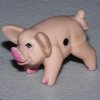Jeopardy Dice Games
Lesson Plans > Mathematics > Problem Solving > Strategy GamesJeopardy Dice Games

Jeopardy Games are a class of games in which you choose to place your points in jeopardy. In other words, you risk your points in hopes of gaining more points. The television game show "Jeopardy" is an example of a jeopardy game; you risk or wager points in hopes of getting more.
Jeopardy Dice Games are jeopardy games which are played with dice. They typically involve a specific roll (or rolls) that end your turn and cause you to lose your points. In each turn you continue rolling until one of the following conditions happen:
- You choose to end your turn, and keep the points you have accumulated in that turn
- You decide to roll "one more time" and that one roll is the "bad" roll that causes you to lose your points for that turn.
Because I typically have small class sizes, I'm able to occasionally play some jeopardy games with my students. I typically save them for the last class period before a vacation (I've had students tell me that Christmas isn't Christmas without Cosmic Wimpout). The reason for playing these games with my math students is to get them thinking about concepts of probability and expected value. Here are two games my students love to play:
Cosmic Wimpout
This is a game played with five dice. One of them is "wild" - instead of a three, it has a sun-and-shooting-star face, which (under most circumstances) counts as whatever you want it to. This is a game with complex rules, and also some downright silly rules (one of which involves running away to join the circus). This game has the interesting feature that there are certain conditions under which you can't end your turn. It's called the "You May Not Want To But You Must" rule. You could have 200 points accumulated in one turn, and then not be allowed to end your turn. This game is a favorite among my students.
Pass the Pigs
This is one of the silliest games. I tell my students, "You're not going to believe what these dice look like." The dice are simply little rubber pigs that can land in any of the following conditions: on their side (two different ways), standing up (called a "hoofer"), on their backs (a "razorback"), on their two front legs and their snout (a "snouter"), or leaning to the side on one leg, one ear, and the snout (a "leaning jowler"). Each configuration counts for a different amount of points (leaning jowlers are the least likely to happen, and therefore are woth the most points). If the dice both land on their sides, with opposite sides up, your turn is over, and your points for that turn are gone.
Getting Creative?
Encourage your students to come up with their own Jeopardy style games. In order to do it well, they have to pay close attention to how likely different results are, in order to give them reasonable point values.

